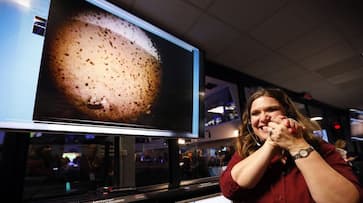Flight controllers at NASA’s Jet Propulsion Laboratory in Pasadena, California, leaped out of their chairs, screaming, dancing and hugging, upon learning that InSight had arrived on Mars, the graveyard for a multitude of previous missions
Cape Canaveral: A NASA spacecraft designed to drill down into Mars’ interior landed on the planet Monday after a perilous, supersonic plunge through its red skies, setting off jubilation among scientists who had waited in white-knuckle suspense for confirmation to arrive across 100 million miles of space.
Flight controllers at NASA’s Jet Propulsion Laboratory in Pasadena, California, leaped out of their chairs, screaming, dancing and hugging, upon learning that InSight had arrived on Mars, the graveyard for a multitude of previous missions.
“Touchdown confirmed!” a flight controller called out just before 3 pm EST, instantly dispelling the anxiety that had gripped the control room as the spacecraft made its six-minute descent.

View of Mars taken by the NASA InSight aircraft (NASA via AP)
Because of the distance between Earth and Mars, it took eight minutes for confirmation to arrive, relayed by a pair of tiny satellites that had been trailing InSight throughout the six-month, 300-million-mile (482-million-kilometer) journey.
The two satellites not only transmitted the good news in almost real time, but they also sent back InSight’s first snapshot of Mars just 4½ minutes after landing.
The picture was speckled with dirt because the dust cover was still on the lander’s camera, but the terrain around the spacecraft looked smooth and sandy with just one sizable rock visible — pretty much what scientists had hoped for. Better photos are expected in the days ahead, after the dust covers come off.
It was NASA’s — indeed, humanity’s — eighth successful landing at Mars since the 1976 Viking probes, and the first in six years. NASA’s Curiosity rover, which arrived in 2012, is still on the move on Mars.
“Flawless,” declared JPL’s chief engineer, Rob Manning. “This is what we really hoped and imagined in our mind’s eye,” he added. “Sometimes things work out in your favor.”
NASA Administrator Jim Bridenstine, presiding over his first Mars landing as the space agency’s boss, said: “What an amazing day for our country.”
InSight, a $1 billion international project, includes a German mechanical mole that will burrow down 16 feet (5 meters) to measure Mars’ internal heat. The lander also has a French seismometer for measuring quakes, if they exist on our smaller, geologically calmer neighbor. Another experiment will calculate Mars’ wobble to reveal the makeup of the planet’s core.
“In the coming months and years even, history books will be rewritten about the interior of Mars,” said JPL’s director, Michael Watkins.
Seven hours after touchdown, NASA reported that InSight’s vital solar panels were open and recharging its batteries.
Over the next few “sols” — or Martian days of 24 hours, 39½ minutes — flight controllers will also assess the health of InSight’s all-important robot arm and its science instruments.
Many Mars-bound spacecraft launched by the U.S., Russia and other countries have been lost or destroyed over the years, with a success rate of just 40 percent, not counting InSight.
NASA went with its old, straightforward approach this time, using a parachute and braking engines to get InSight’s speed from 12,300 mph (19,800 kph) when it pierced the Martian atmosphere, about 77 miles (114 kilometers) up, to 5 mph (8kph) at touchdown. The danger was that the spacecraft could burn up in the atmosphere or bounce off it.
The three-legged InSight settled on the western side of Elysium Planitia, the plain that NASA was aiming for. Project manager Tom Hoffman said the spacecraft landed close to the bulls-eye, but NASA did not have yet have the final calculations.
He said that it was hard to tell from the first photo whether there were any slopes nearby, but that it appeared he got the flat, smooth “parking lot” he was hoping for.
Museums, planetariums and libraries across the US held viewing parties to watch the events unfold at JPL. NASA TV coverage was also shown on the giant screen in New York’s Times Square, where crowds huddled under umbrellas in the rain.
The 800-pound (360-kilogram) InSight is stationary and will operate from the same spot for the next two years, the duration of a Martian year. It will take months to set up and fine-tune the instruments, and lead scientist Bruce Banerdt said he doesn’t expect to start getting a stream of solid data until late next spring.
“It’s going to be awesome. I can’t wait to start seeing marsquakes,” Hoffman said.
Mars’ well-preserved interior provides a snapshot of what Earth may have looked like following its formation 4.5 billion years ago, according to Banerdt. While Earth is active seismically, Mars “decided to rest on its laurels” after it formed, he said.
By examining and mapping the interior of Mars, scientists hope to learn why the rocky planets in our solar system turned out so different and why Earth became a haven for life.
Still, there are no life detectors aboard InSight. NASA’s next mission, the Mars 2020 rover, will prowl for rocks that might contain evidence of ancient life.
The question of whether life ever existed in Mars’ wet, watery past is what keeps driving NASA back to the fourth rock from the sun.
Last Updated Nov 27, 2018, 10:15 AM IST









![Salman Khan sets stage on fire for Anant Ambani, Radhika Merchant pre-wedding festivities [WATCH] ATG](https://static-gi.asianetnews.com/images/01hr1hh8y86gvb4kbqgnyhc0w0/whatsapp-image-2024-03-03-at-12-24-37-pm_100x60xt.jpg)
![Pregnant Deepika Padukone dances with Ranveer Singh at Anant Ambani, Radhika Merchant pre-wedding bash [WATCH] ATG](https://static-gi.asianetnews.com/images/01hr1ffyd3nzqzgm6ba0k87vr8/whatsapp-image-2024-03-03-at-11-45-35-am_100x60xt.jpg)


